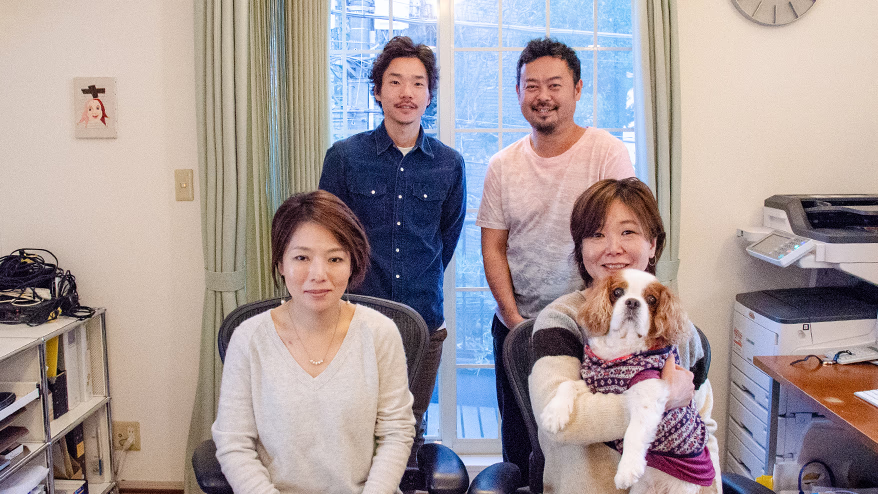こんにちは。セールス部の奥山です!
「私、あなたの会社売ります!」は、私たちセールス部員が「この会社こそは!」という他社様を、あたかも自社のように宣伝させていただくコーナーです。
連載9回目となる今回、登場いただくのは株式会社オフィスカゴ様。一軒家をリフォームしたオフィスの1階は「チャーリーとクマの部屋」という共同アトリエになっていて、階段を上がった先がワークスペースに。扉を開けると、オフィス犬のチャーリーがしっぽを振って出迎えてくれます。
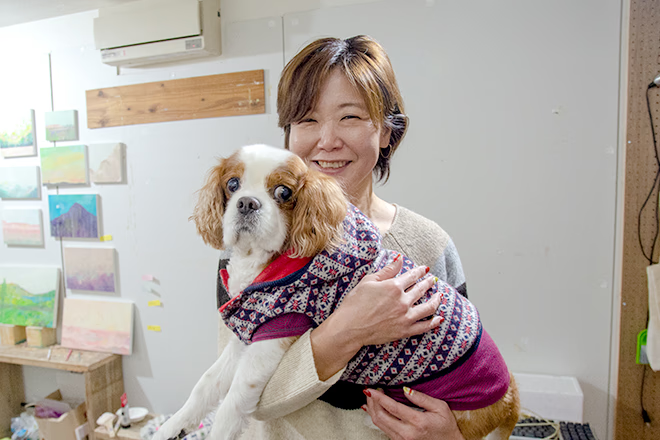
デジタルコンテンツの企画、制作、運用を行い、近年はデジタルサイネージの分野で注目を集めているオフィスカゴさんを引っ張るのは、代表取締役の城あきこさん。1997年に大阪で同社を創業し、現在までクリエイターとして一線に立ち続けています。
そんなオフィスカゴさんとモノサスのつながりは、2014年にとある放送局のWebサイトの制作でお声掛けをいただいたのが始まりです。
サイトオープン直前まで奮闘が続いた思い出深い案件で、その後もサイトの改修などでご一緒させていただき、私、奥山は城さんの明るいキャラクターが作り出すオフィスカゴさんのアットホームな雰囲気に惹かれ続けてきました。
今回は、デジタルコンテンツやサイネージという最先端のクリエイティビティと、遊び心あふれるやわらかな雰囲気が共存する同社のヒミツに迫りたいと、城あきこさん、企画・制作部の小林崇亮さんにお話を伺いました。
インタビューに協力してくださった方々
-

-
城あきこさん :
代表取締役・デザイナー
デザイナーとして20年余年、いつの間にか会社になっていました。2018年は弊社にとって新しいフェーズに挑戦する年でした。
-
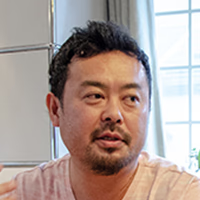
-
小林崇亮さん :
企画・制作部 プランナー / ディレクター
ちゃんと朝出勤して夜まで仕事はしています。依頼を受ける所謂受託案件もありがたい仕事ですが、自ら価値を創出していくことも視点として持ちながら日々試行錯誤しています。
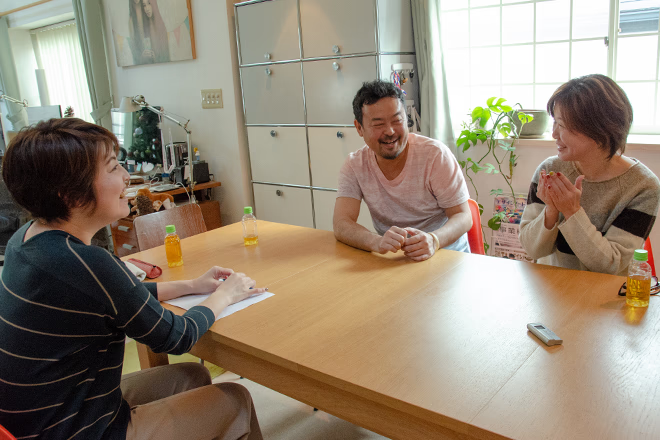
手弁当で何かを生み出そうとしていた
20代の頃の活動が今につながっている
ーー 今回インタビューのお願いをしてから気づいたんですが、じつはオフィスカゴさんの歴史をあまりうかがったことがなかったですよね。創業時は城さんお一人だったんですか?
-
 城さん
城さん -
はい、1997年のことです。当時、大阪の天神橋筋6丁目という日本一長いアーケードの商店街の一角に、阪急電鉄が開設したインキュベーションオフィスがあって、そこの3畳のブースで創業しました。お隣も3畳、広いところで6畳という、デジタル長屋みたいな温かい環境でしたね。
そこに4年くらいいたんですが、最初の1年半はフリーランスの個人事業主。その後、お客様から「会社にしてね」と言われ、有限会社になり、東京に出たという流れです。
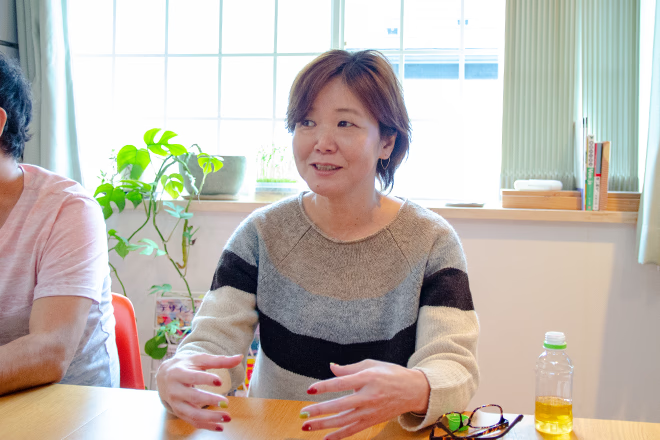
ーー 東京へはどういう経緯で進出したんですか?
-
 城さん
城さん -
東京の仕事の比率が増えて、出張を繰り返していたある日、体を壊して3週間も東京で入院する事になってしまったんです。これはもう東京にいないと体がしんどいので「移ろう」と。
そう決心したら入院中もじっとしていられなくて、外出許可をもらっては家を探し、退院までに新居を決めてしまいました。それが2002年ですね。
ただ、その後も東京のお仕事が半分強で、大阪が半分弱。インキュベーションオフィス時代の仲間が大阪にたくさんいるので、いろいろ手伝ってもらって、今も大阪のお仕事もさせていただいています。
ーー 定期的に大阪にも行っているんですか?
-
 城さん
城さん -
大阪のクライアントにもスタッフを常駐させているので、定期的に帰っています。実家もありますし。出張というよりは"帰っている"という感覚なんですよ。東京での暮らしが長くなりましたが、ソウルはまだ大阪なんでしょうね 。
ーー 大阪時代はどんなお仕事をされていたんですか?
-
 城さん
城さん -
Webサイト制作はもちろんですが、Illustratorのベクター形式のファイルでアニメーションが作れるFuture Splash Animator(1996年)を当時の仲間に教えてもらい、Webアニメーションというものにかなりハマりまして。すぐにそのソフトは、Macromedia Flashになったんですが、Flashを使ったアニメーションの企画・制作、データベースと連動して動的なコンテンツを動かすWebサイト制作のお手伝いなどをやらせていただいていました。
今、サイネージのアニメーションコンテンツ制作をしているのも、その流れがあったからなんです。
-
 小林さん
小林さん -
仕事場で生放送もやってたんだよね?
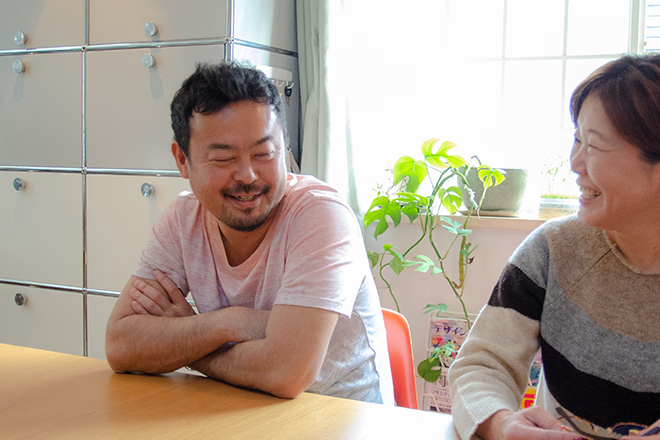
-
 城さん
城さん -
そう。インキュベーションオフィスまわりの仲間たちと一緒に、ストリーミング生放送の番組を、誰に頼まれたわけでもなく足掛け4年も続けてしまいました。心の広いクライアントがブロードバンドのインフラを無料で使わせてくださって、松竹芸能の若手のタレントさんに出演していただき、ちゃんとした大阪のお笑いの生放送の番組の体裁にしていましたね。
-
 小林さん
小林さん -
ニコ動もYouTubeもない頃に。
-
 城さん
城さん -
当時は、放送を見る側のユーザーはナローバンドの時代だったので、RealPlayerのすごく小さな画面で、音はクリアに聞かせるけど、映像は10秒に一コマとか。そんな時代でした。映像がない分、チャットを使って大喜利してユーザーと遊んだり、オフライブと称して300人規模のライブを開催したり。今だと簡単にできることですが、時代が早すぎましたね(笑)。
-
 小林さん
小林さん -
当時だからこその状況だよね。
-
 城さん
城さん -
本当に。それでインキュベーションオフィスの仲間や、出演してくれていた若手タレントさんと、終わった後にみんなで朝まで話して飲むのが楽しかった。20代の後半ってそんな時期ですよね。
-
 小林さん
小林さん -
インフラを提供してくださったクライアントとはずっと仕事が続いていて、チャレンジングな領域の内容にもなっているのは、当時のおもしろい時間があったからでしょう。
-
 城さん
城さん -
そうかもしれないですね。ありがたいことです。
あと、うちが今でもWebアニメーションなど"やわらかい系"のコンテンツ作りが得意なのも、この頃からの流れかなあと。
例えば、インターネットにつながったサイネージで、あると便利なのが時報や時計なんですが、これを「たこ焼き」で表現した作品は、2015年のデジタルサイネージアワードのクリエイティブ賞をいただきました。これを作ったときは、全員で実際にたこ焼きを焼きながらコマ撮りをしていくため、毎夜毎夜、たこ焼きを作っては食べるという日々で・・・。
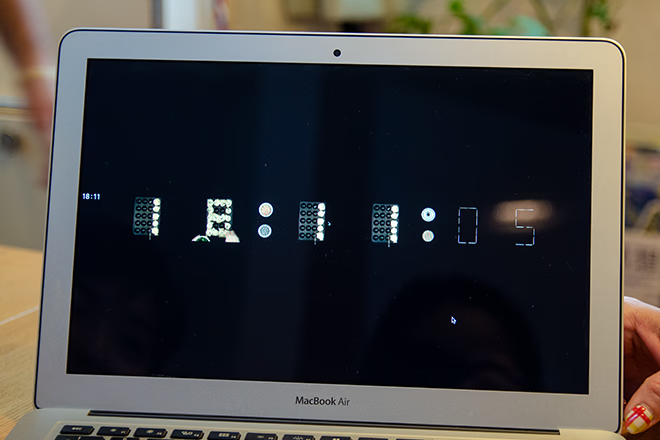
たこ焼き器で焼いているたこ焼きの数が変わることで時刻が変化していくデジタルサイネージ
-
 小林さん
小林さん -
太ったよね。
-
 城さん
城さん -
みんなで、ぷくぷくになってしまったんですけどね(笑)。
時報や時計のコンテンツはいろんなものを今まで作らせていただいたのですが、これは実写ゆえ、レシピまで凝ったりして、思い出の仕事ですね。
とはいえ、Flashは2020年でサポートが終了になるので、今後の動的なデータを取り込むWeb上のアニメーションはHTML5でやらなければいけない。そこはモノサスさんにもまた助けて頂きたいところなんです。会社としても、力を入れていければなと思って取り組んでいます。
得意な人の力を引き出しながら仕事をする
協業スタイルで案件をゴールに導く
ーー ちなみに、小林さんは「全日本さば連合会」の会長という肩書もお持ちだとか。そのあたりのお話を伺う前に、そもそもどういう経緯でオフィスカゴに加わったんですか?
-
 小林さん
小林さん -
城さんが東京に出てきた頃、僕は武蔵小山で印刷屋さんの机を1つ借りてデザイナーとして「ふむふむオフィス」というオフィスをやり、並行して全日本さば連合会という鯖好きの会を立ち上げて、鯖料理を食べる「鯖ナイト」というイベントを始めていたんですね。
その会のメンバーの友達だったのが城さんで、昼メシを食ったんですよね。
-
 城さん
城さん -
同業者ですねーって、それがきっかけですね。
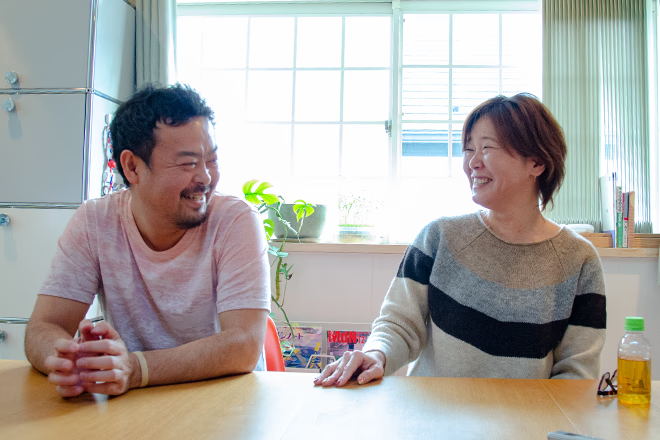
-
 小林さん
小林さん -
そしたらある日突然、電話がかかってきたんですよ。「ここ(オフィスカゴ)に間借りしませんか?」と。それが2013年10月で。
-
 城さん
城さん -
あの頃はもうかなりのボリュームの仕事をしていたんですけど、案件ごとにいろんな人でチームを組むスタイルでやっていたんですね。案件が終わったら解散して、継続運用のものはチームも継続。会社には私だけという形態。だから、正直"電話番"もほしかった(笑)。
でも、それがきっかけで、やっぱりちゃんとした組織にしないと、と思い、株式会社にして社員も雇用して、今の形態の「オフィスカゴ」になりました。
ーー モノサスも社員が増えてから、組織のあり方を模索し続けています。フルフレックスを取り入れるなど、いろいろな取り組みを行っていますが、すべてがうまくいくわけではありません。そのあたり、城さんはどうされていますか? 社員は増えても、有機的なつながり方は変わらないですか?
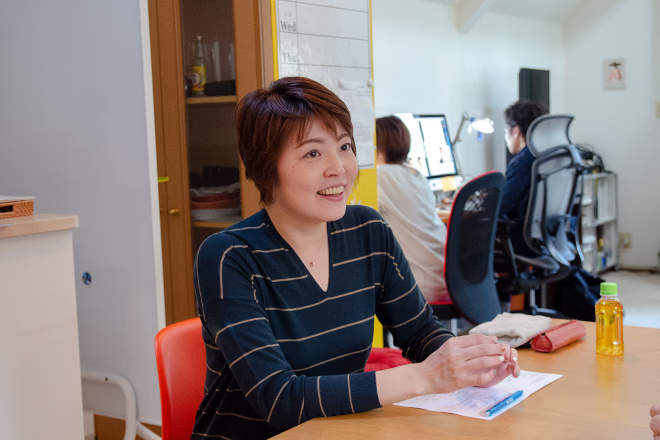
-
 城さん
城さん -
今では少し人数は増えましたが、その案件に最適な人や会社に関わってもらうスタイルは変わっていません。ある部分は社外のパートナーの力を借り、ある部分は社内で、というスタイルです。ただ、これから先は変えたい部分と変えたくない部分があります。
例えば、今のデジタルコンテンツに必要不可欠なフローや旬な制作手法に関しては、社外のパートナーの力を借りつつも、社内のスキルとして積んでいきたい。その仕組みは整えていきたいと思っています。
モノサスさんをはじめ、協業できる仲間のような会社がいくつもある状態でこの先もやっていけたらなと。これは私がインキュベーションオフィス出身だからこその感覚かもしれないですね。
ものづくりする人たちとの共存が
会社に好影響を与えることも
ーー ところで、私がもう1つ大きな興味を抱いているのが、オフィスカゴさんが「部活動」と呼んでいる仕事以外の活動です。まず、オフィス1階の共同アトリエ「チャーリーとクマの部屋」や、小林さんの鯖の活動について教えていただけますか?
-
 城さん
城さん -
共同アトリエの始まりは、私が通っていた絵画教室で出来た仲間たちが一緒に普段から描ける場所を探していたから。鯖の活動は小林がそもそもやっていたから。
会社のスタッフは、必ずしも所属はしていませんが、たまに参加したり、たまに実務をしたり、たまにゆっくり話したり、けどいつも同じ空間を共にする事でお互いに刺激があったり、なにかが生まれるかもしれない関係性で継続させているというか。
非常に説明しにくいのですが、インキュベートする仲間たちとの空間の事をオフィスカゴでは部活動と呼んでいます。
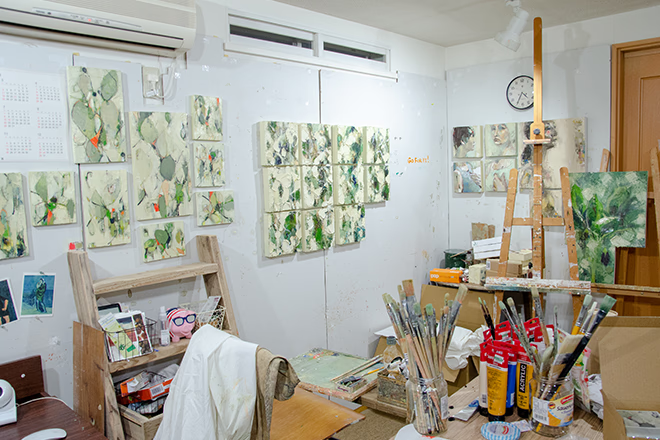
オフィス一階のアトリエ
-
 城さん
城さん -
3階にデジタルで物を作っている人たちがいて、1階には絵の具だらけで絵を描く人がいる部屋があるって、ものづくりの会社としていい刺激があるのではないか、と。夜、会社帰りに絵を描きに来た人が下から「入りまーす!」って声が聞こえてきて、今も2人展をやりたい人が絵を描いています。ただ、オフィスですから、使う人とはきちんとNDAは結んでいます。
集まっているのは、さまざまな業種の人たちですが、なぜかデジタルでのものづくり寄りの業界の人たちが多く、刺激をもらっています。
一方で、「鯖」については美味しい、楽しいだけじゃなく、小林がどういうふうに事業にしていくのかな?と興味を持って見ています。
ーー 小林さんが会長を務める「全日本さば連合会」は、自治体を巻き込んだイベント「鯖サミット」を開催していますよね。最初からここまで大々的にやっていく構想があったんですか?
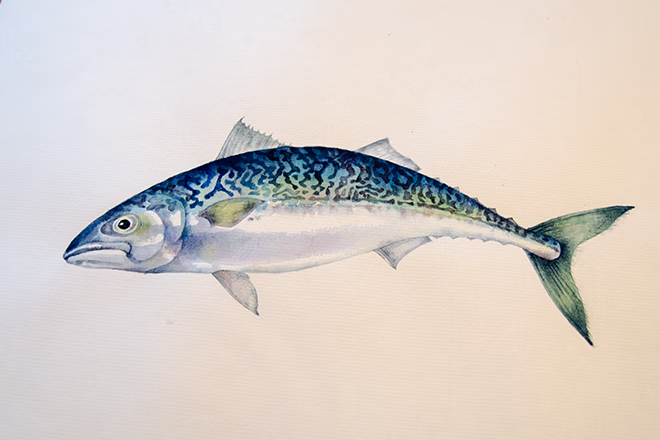
スタッフの方が描いた鯖の絵。今にも動きだしそうです
-
 小林さん
小林さん -
活動をしていくうちに、というのが正直なところです。ただ、やろうとしていたことははっきりしていました。
それは、消費者と産地を結びつけること。今は年に一回開催している「鯖サミット」というイベントのパーマネントな事務局を担っています。「鯖サミット」は全国各地の鯖や鯖料理が味わえる食のイベントです。こういうイベントって人口の多い東京など都市部で開催するのが普通なのかもしれませんが、「鯖サミット」は鯖の産地で開催しています。しかも開催地は毎年変わっていきます。2018年は旬さば(ときさば)の産地である長崎県松浦市で開催しました。
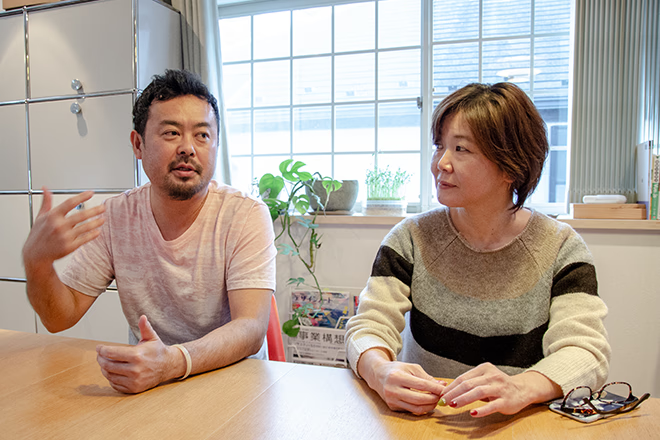
-
 城さん
城さん -
私も行きましたが、遠かった(笑)。でも、すごいお客さんの数と熱気でしたね。
-
 小林さん
小林さん -
遠くからも来てくださる人がいて、今回の松浦では約4万5000人の来場がありました。市の人口は2万3000人です。青森から鹿児島、海外も含めて31ブースの出店がありました。鯖は産地によって食べ方などにも違いがあって地域性が豊かなんです。そんな各地の鯖料理を味わってもらって、開催地にも喜んでもらう、というイベントです。次の開催地は未定ですが、鯖の産地で1年に1回やるという仕掛けは続きます。
ーー 31も産地があるということは、しばらく終わりはないですね。
-
 小林さん
小林さん -
言い出しっぺですから、やめられなくなっている(笑)。僕は会津若松の出身で山間の育ちなんですけど、鯖が昔から好きだったんですよ。
ーー 部活動で得たものが、オフィスカゴでの仕事に生かされる部分もありますか?
-
 小林さん
小林さん -
「鯖サミット」では、準備から開催まで多くの関係者とやり取りします。市や県など自治体や漁協など当地の鯖ブランド推進団体の方々、観光協会や商工会、旅行業、流通、メディアなどさまざまです。協力をお願いしてまわったり、1つのことをいろいろな切り口で説明するシーンがあったりしますが、企画を進めるノウハウはどんな仕事にも共通する部分はあると思いますし、それはオフィスカゴの仕事でも生きているのかなと思います。
ーー モノサスにも部活動的な活動はあるんですが、継続性と仕事への相乗効果はどうかな? と思うこともあって……。
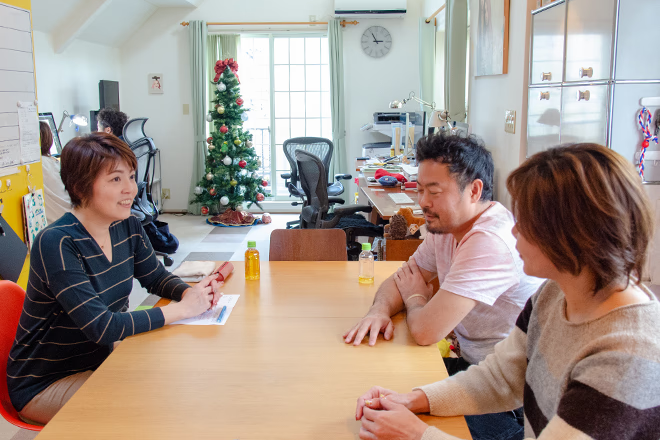
-
 小林さん
小林さん -
仲間内で飲み会をやっているだけでは相乗効果は出てきませんよね。でも、対外的な関係が出てくると、やらなくてはいけないから、作り始める。企画を提出し、営業し、人を巻き込み、形にしていく。個々の社員がそういう経験を積むことは、会社にとっても大きなリターンがあると思います。
もちろん、社員みんながみんな、やる必要もできる必要もないと思うけど、部活動的な活動からそういうことを学んだ人がぽっと出てくると、会社にとってはメリットがありますよね。
お互いを尊敬し、支え合える関係性
それが高品質のクリエイティブを生み出す
ーー 今日お話ししていて改めて、オフィスカゴのアットホームな雰囲気を作っているのは城さんのキャラクターなんだなと思いました。すぐ側にいる小林さんから見て、城さんどんな存在ですか?
-
 小林さん
小林さん -
クリエイティブに関するモチベーションと責任感、プライドの高さは非常に勉強になります。すごく尊敬しています。例えば、今年の5月に「APPS JAPAN(アプリジャパン)2018」という展示会にサイネージのコンテンツを展示したんですよ。
-
 城さん
城さん -
会社として初めてブースを出してみたんです。ただ、そもそも出展の経験がなくて「何からするの?」という状態で。
-
 小林さん
小林さん -
僕は以前、観光系の展示会に出展した経験があったので「手伝いますよ」と社内会議をしてみたんですけど、その時点では誰も何もわかっていないし、物もできていないし、どないんすんねん? と。そこで、スケジュールをばーっと立てて。
-
 城さん
城さん -
そういうところすごく尊敬しています。
-
 小林さん
小林さん -
城は納得したら寝ずにでもやるんですよ。最終的に絶対に投げない。自分の理想の形をスケジュールの中でしっかり作り上げてくるんですね。まさにクリエイターだなと思いました。
ただ、片付けがすごいヘタだし、物はなくすし、そこは腹立ちますけど。作るものがステキ。こっちもできる限りサポートしたいという感覚になれます。
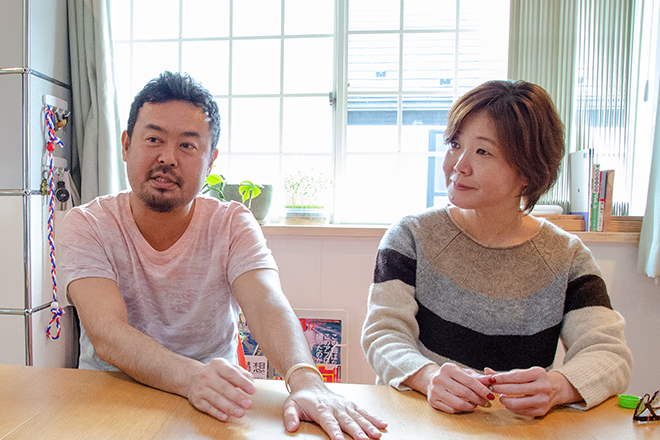
ーー ここはすごいけど、ここは少し抜けていて、でもだからこそ、お互いにサポートできる。そんな関係性がステキですね。集まっていて、つながれるというか。
-
 城さん
城さん -
そうですよね。クリエイターはぶつかるものですし、発展的なぶつかり合いならぶつかった方がいい。でも、なんでも安心して言えるような関係性はすぐにはできないから、普段から作っておかないと。
「それは違うと思います!」と言えなくなっちゃうのはおかしいですから。みんなが得意分野を出せるような組織でいたいよね、とは話しています。なんだか、ほわっとしていますけど。
ーー おふたりが、一緒に仕事をする人に求めているのは?
-
 小林さん
小林さん -
僕は、飲める人かなぁ。2人で、「ほえー」っと言いながら飲める人。苦手な人とはサシで飲みたくないでしょう。そういう意味で価値観が重なる人がいいですね。
-
 城さん
城さん -
クリエイティブ魂かな。ものづくりの現場において、「自分の目が黒いうちは絶対にここは裏切らない」という感覚を自分の中に持っている人。もちろん、その上で一緒に仕事がしやすい人だとありがたいですけどね(笑)。
奥山秀野の「ココが売りたい!」
今回のインタビューを終えて、オフィスカゴさんのアットホームな雰囲気の秘密を垣間見ることができました。城さん、小林さを筆頭に一人ひとりが得意な分野を持ち、独立しながらお互いを尊敬し、応援し合っている。そんな理想的な関係性にうらやましさを感じてしまいました。
その上で、私がますます売りたくなってしまったオフィスカゴさんの魅力は次の2つのポイントです。
1. 決めたことから決して逃げないクリエイター魂
2. 社内外のパートナーとの信じ合い補完し合う関係性
お話をうかがっていて、強く感じたのは社内外のパートナーとの強い絆でした。お互いを信じ合う関係性を築き上げている会社の仕事ぶりを信じられないわけがありません。
そして、社長業がメインかと思っていた城さんがここまでクリエイティブの一線にかかわっているとは驚きました。もし、サイネージに関する相談事があるというクライアントさんがいたら、私は100%の自信を持って「オフィスカゴさんに相談してみては?」と言います。
オフィスカゴさんもモノサスも、お互いが新たなことにチャレンジするときには協力し合ったり、相談できる関係をこれからも作っていきたいと思っています。
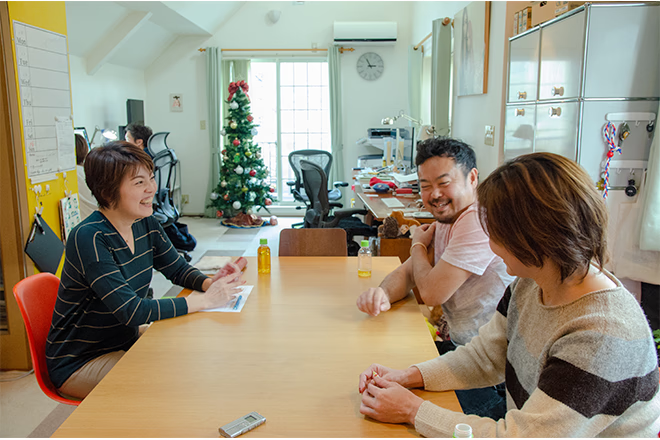
株式会社オフィスカゴ
東京都渋谷区広尾3-12-4
https://kago.co.jp/
